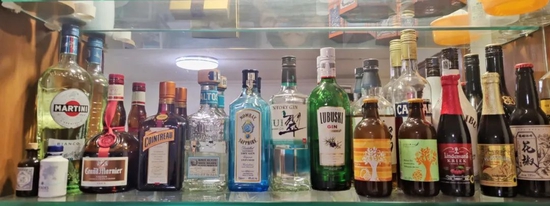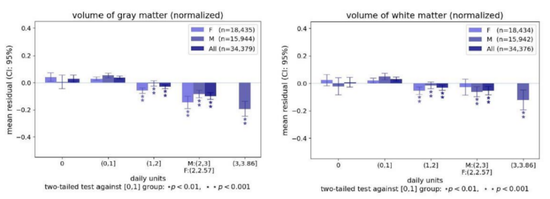来源:奇点网
提到酒想到的是,战斗民族的伏特加,慕尼黑的啤酒节,以及“东篱把酒黄昏后,有暗香盈袖”。
有人说,小酌怡情;也有人说,喝红酒软化血管;还有人说(比如东北人),饺子就酒,越喝越有。以上种种,无疑表达了人们对酒的喜爱。
但越来越多的研究表明,酒精不仅伤肝、伤胃,还伤心。甚至“喝酒喝坏脑子”也并非危言耸听。
近期,来自美国、瑞士、荷兰的七位学者在《自然·通讯》上发表重要研究成果,基于UK Biobank中36678名健康中老年人的脑部影像数据,他们发现饮酒量与脑容量呈负相关[1]。
哪怕每天只摄入1-2个单位的酒精(1单位为10ml酒精),饮酒量与脑容量的负相关就已经很明显,随着饮酒量的攀升,二者相关性愈发显著。

2016年发表在《柳叶刀》上全球疾病负担研究(GBD)表明[2],在全球每年因各种原因去世的3200多万人中,饮酒直接造成了280万人的死亡,是第七大致病/致残因素。
慢性酗酒与心血管疾病、营养不良、癌症和加速衰老密切相关[3-6]。长期饮酒人群的大脑结构和功能连接也产生变化[7-9]。
一项meta分析表明,与健康对照组(n=498)相比,酒精依赖症(AUD)个体(n=433)皮质纹状体-边缘回路(包括前额叶皮质、岛叶、颞上回、纹状体、丘脑和海马)的灰质体积(GMV)更小[10]。
此外,脑白质(WM)微结构异常也是酒精依赖症(AUD)的一个标志性变化,多项神经影像学研究发现AUD个体胼胝体的白质退化[11-13]。
尽管迄今为止已有大量文献报道了酒精依赖症(AUD)个体饮酒与大脑结构的相关性,但对于没有AUD的人群来说,相关性又当如何呢?
一些研究显示,中老年人群的中度酒精摄入伴随着大脑总容量降低、灰质萎缩,以及额叶和顶叶的灰质密度降低[14-16]。但也有一项研究指出,轻中度酒精摄入与灰质体积呈正相关[17]。
众说纷纭之下,轻中度酒精摄入对大脑的影响更加显得扑朔迷离。小型研究的统计效能有限,再加上没有考虑到诸如性别、BMI、年龄、遗传等相关协变量的影响,可能导致结果的偏差。
因此,大样本研究迫在眉睫。国际上规模最大的生物医学大数据平台非UK Biobank(UKB)莫属[18]。因而在UKB中40-69岁英国人口的高质量脑部扫描数据的基础上开展研究,难免有种站在巨人肩膀上的感觉。
正如本文的一位研究者,来自美国宾夕法尼亚大学沃顿商学院的Gideon Nave所说,“拥有这样的数据集就像拥有一个强大的显微镜或望远镜,在更高分辨率的基础上,我们开始看到以前看不到的模式和关联。”

研究共纳入了36678位受试者,他们的酒精摄入从滴酒不沾到每天4个酒精单位不等。
为揭示饮酒与大脑的潜在关联,研究团队控制了年龄、身高、用手习惯、性别、吸烟状况、社会经济状况、遗传背景和居住地等变量。此外,他们还基于受试者的头颅尺寸,对脑容量数据进行了校正。
根据饮酒量将参与者分组后,不难发现,每天0到1个酒精单位对脑容量没有明显影响,但每天1到2个酒精单位与大脑灰质和白质减少就显著相关。
随着饮酒量增加,大脑的灰质和白质体积逐渐减小,并且这种变化不是线性的。正如本文第一作者,来自美国威斯康辛商学院的Remi Daviet所说,喝得越多,情况越糟。


此外,脑容量的降低并非局限在某一个脑区,而是普遍存在于整个大脑中,这与衰老所导致的变化相似。
因此,研究人员对饮酒和衰老导致的大脑体积缩小进行了比较。
通过建模得知,对于50岁的人群,从滴酒不沾到每天摄入4个酒精单位,相当于大脑衰老了超过10岁!
只要迈出了饮酒的第一步,哪怕从“零”转变为平均每天摄入1个酒精单位,其大脑也相当于衰老了0.5岁!


宾夕法尼亚大学成瘾研究中心主任Henry R。 Kranzler说道:“这些发现与政府在安全饮酒限量的指导方针明显相悖。
尽管国家酒精滥用和酒精中毒研究所建议女性/男性平均每天饮酒不超过1杯/2杯,但这个酒精摄入量已经超出了与脑容量下降相关的最低饮酒量。”
本项大样本研究无疑揭示了饮酒与大脑的密切关系。但遗憾的是,横断面研究无法给出二者的因果关系。
此外,研究者希望未来可利用UK Biobank和其他大型数据库来探索更多饮酒相关问题。例如,本项研究关注的是平均摄入量,那么每天喝一杯,与一周工作日不喝,周末喝七杯相比,哪个更好呢?

参考文献:
[1] Daviet R, Aydogan G, Jagannathan K, et al。 Associations between alcohol consumption and gray and white matter volumes in the UK Biobank。Nat Commun。 2022;13(1):1175。 Published 2022 Mar 4。 doi:10.1038/s41467-022-28735-5。
[2] GBD 2016 Alcohol Collaborators。 Alcohol use and burden for 195 countries and territories, 1990-2016: a systematic analysis for the Global Burden of Disease Study 2016 [published correction appears in Lancet。 2018 Sep 29;392(10153):1116] [published correction appears in Lancet。 2019 Jun 22;393(10190):e44]。Lancet。 2018;392(10152):1015-1035。 doi:10.1016/S0140-6736(18)31310-2。
[3] Zaridze D, Lewington S, Boroda A, et al。 Alcohol and mortality in Russia: prospective observational study of 151,000 adults [published correction appears in Lancet。 2014 Apr 26;383(9927):1464]。Lancet。 2014;383(9927):1465-1473。 doi:10.1016/S0140-6736(13)62247-3。
[4] Zahr NM, Sullivan EV, Rohlfing T, et al。 Concomitants of alcoholism: differential effects of thiamine deficiency, liver damage, and food deprivation on the rat brain in vivo。 Psychopharmacology (Berl)。 2016;233(14):2675-2686。 doi:10.1007/s00213-016-4313-y。
[5] Rehm J, Shield KD, Weiderpass E。 Alcohol consumption。 A leading risk factor for cancer。Chem Biol Interact。 2020;331:109280。 doi:10.1016/j.cbi.2020.109280。
[6] Robinson O, Chadeau Hyam M, Karaman I, et al。 Determinants of accelerated metabolomic and epigenetic aging in a UK cohort。Aging Cell。 2020;19(6):e13149。 doi:10.1111/acel.13149。
[7] Sullivan EV, Pfefferbaum A。 Brain-behavior relations and effects of aging and common comorbidities in alcohol use disorder: A review。Neuropsychology。 2019;33(6):760-780。 doi:10.1037/neu0000557。
[8] de la Monte SM, Kril JJ。 Human alcohol-related neuropathology。Acta Neuropathol。 2014;127(1):71-90。 doi:10.1007/s00401-013-1233-3。
[9] Galandra C, Basso G, Cappa S, Canessa N。 The alcoholic brain: neural bases of impaired reward-based decision-making in alcohol use disorders。Neurol Sci。 2018;39(3):423-435。 doi:10.1007/s10072-017-3205-1。
[10] Yang X, Tian F, Zhang H, et al。 Cortical and subcortical gray matter shrinkage in alcohol-use disorders: a voxel-based meta-analysis。Neurosci Biobehav Rev。 2016;66:92-103。 doi:10.1016/j.neubiorev.2016.03.034。
[11] Monnig MA, Tonigan JS, Yeo RA, Thoma RJ, McCrady BS。 White matter volume in alcohol use disorders: a meta-analysis。Addict Biol。 2013;18(3):581-592。 doi:10.1111/j.1369-1600.2012.00441.x。
[12] Kong LM, Zheng WB, Lian GP, Zhang HD。 Acute effects of alcohol on the human brain: diffusion tensor imaging study。AJNR Am J Neuroradiol。 2012;33(5):928-934。 doi:10.3174/ajnr.A2873。
[13] Pfefferbaum A, Sullivan EV。 Disruption of brain white matter microstructure by excessive intracellular and extracellular fluid in alcoholism: evidence from diffusion tensor imaging。Neuropsychopharmacology。 2005;30(2):423-432。 doi:10.1038/sj.npp.1300623。
[14] Paul CA, Au R, Fredman L, et al。 Association of alcohol consumption with brain volume in the Framingham study。Arch Neurol。 2008;65(10):1363-1367。 doi:10.1001/archneur.65.10.1363。
[15] Mukamal KJ, Longstreth WT Jr, Mittleman MA, Crum RM, Siscovick DS。 Alcohol consumption and subclinical findings on magnetic resonance imaging of the brain in older adults: the cardiovascular health study。Stroke。 2001;32(9):1939-1946。 doi:10.1161/hs0901.095723。
[16] den Heijer T, Vermeer SE, van Dijk EJ, et al。 Alcohol intake in relation to brain magnetic resonance imaging findings in older persons without dementia。Am J Clin Nutr。 2004;80(4):992-997。 doi:10.1093/ajcn/80.4.992。
[17] Sachdev PS, Chen X, Wen W, Anstey KJ。 Light to moderate alcohol use is associated with increased cortical gray matter in middle-aged men: a voxel-based morphometric study [published correction appears in Psychiatry Res。 2009 May 15;172(2):173。 Anstry, Kaarin J [corrected to Anstey, Kaarin J]]。Psychiatry Res。 2008;163(1):61-69。 doi:10.1016/j.pscychresns.2007.08.009。
[18] Sudlow C, Gallacher J, Allen N, et al。 UK biobank: an open access resource for identifying the causes of a wide range of complex diseases of middle and old age。PLoS Med。 2015;12(3):e1001779。 Published 2015 Mar 31。 doi:10.1371/journal.pmed.1001779。
[19]https://scitechdaily.com/more-alcohol-less-brain-association-begins-with-an-average -of-just-one-drink-a-day/。
























